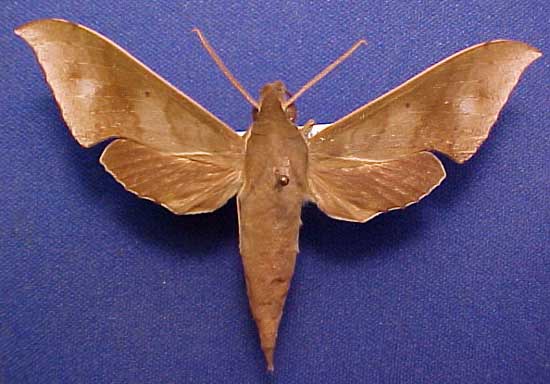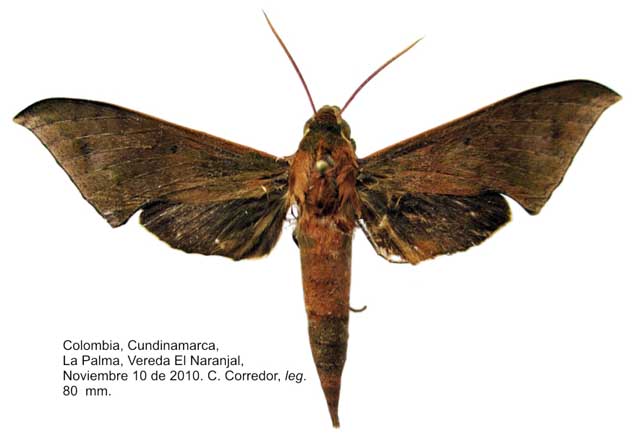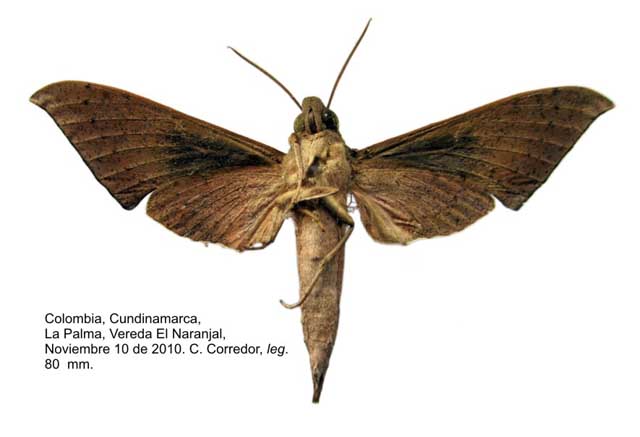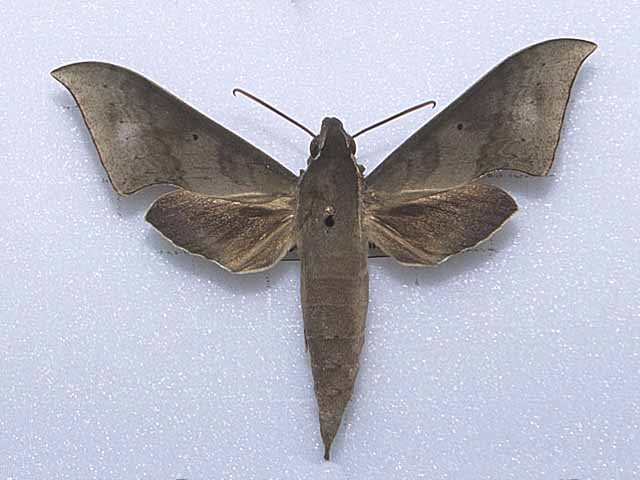Xylophanes germen yurakano
Xylophanes germen yurakano
zail-AH-fan-eesmmJER-menmmyour-uh-KAY-noh
Lichy, 1945

Xylophanes germen yurakano courtesy of John Vriesi.
This site has been created by
Bill Oehlke at oehlkew@islandtelecom.com
Comments, suggestions and/or additional information are welcomed by Bill.
TAXONOMY:
Family: Sphingidae, Latreille, 1802
Subfamily: Macroglossinae, Harris, 1839
Tribe: Macroglossini, Harris, 1839
Genus: Xylophanes Hubner [1819] ...........
Species: germen yurakano Lichy, 1945
|
MIDI MUSIC
.....It's a Wonderful World.....
copyright C. Odenkirk
ON.OFF
<bgsound src="world.mid" LOOP=FOREVER>
|
DISTRIBUTION:
Xylophanes germen yurakano moths
(wingspan: approximately 80-85mm)
fly in
Venezuela: Aragua; the specimen type locality, and west and south to
Colombia: Cundinamarca (RTN);
Bolivia: Cochabamba, La Paz: Murillo, Río Zongo, (750m).

Xylophanes germen yurakano, Cundinamarca, Colombia,
80mm, November 10, 2010, courtesy of Rodrigo Torres Nunez,
tentative id by Bill Oehlke.

Xylophanes germen yurakano, Cundinamarca, Colombia,
80mm, November 10, 2010, courtesy of Rodrigo Torres Nunez,
tentative id by Bill Oehlke.
I do not know geographic differences between nominate germen and subspecies yurakano, but I have gone with the latter
due to limited contrast on forewing, very produced and pointed apex, and relatively straight (limited crenulation) forewing outer margin. Bill Oehlke.
CATE: "Very similar to Xylophanes germen germen but larger, more elongate and less crenulated forewings.
"Forewing upperside a more uniform olive brown than Xylophanes germen germen, with a less contrasting pattern; the orange-brown patch between M3 and the inner
margin in many Xylophanes germen germen is consistently absent."
The pronunciation of scientific names is
troublesome for many. The "suggestion" at the top of the page is
merely a suggestion. It is based on commonly
accepted English pronunciation of Greek names and/or some
fairly well accepted "rules" for latinized scientific names.
The suggested pronunciations, on this page and on other pages,
are primarily put forward to assist those who hear with internal
ears as they read.
There are many collectors from different countries whose
intonations and accents would be different.
Jean Marie Cadiou writes, "When I say "Xylophanes" in English I
pronounce it something like "Zailophanees", with the emphasis on the
"o". The French pronounce it differently, something like
"Kzeelophaness" with no emphasis, and the Germans yet in a
different way..."
Some of the early describers/namers chose genus
and species names indicating some character of the insect, but more
often, they simply chose names from Greek or Roman mythology or
history.Those species names which end in "ensis" indicate a
specimen locale, and those which end in "i", pronounced "eye", honour
a contempory friend/collector/etc.
In Greek myth, Phanes is the golden winged Primordial Being who
was hatched from the shining Cosmic Egg that was the source of the
universe. He personifies light emerging from chaos.
"Xylo" is the Greek word for wood.
The specimen type for the genus
Xylophanes is Xylophanes anubus. Perhaps ? when Hubner
examined that species, the yellow-orange and brown tones of the
forewings suggested wings of wood.
"Germen" is the Latin word for seed, possibly chosen for the
seed-cover-like brown colouration of the moth.
I have no idea of the origin of "yurakano".
FLIGHT TIMES:
Xylophanes germen yurakano adults
probably fly in every month of the year. If my id of the Colombian specimen is correct, there is at least a November flight in that country.

Xylophanes germen yurakano male courtesy of
Hubert Mayer
copyright.
ECLOSION:
Pupae probably wiggle to surface from subterranean chambers or leaf litter just prior to
eclosion.
SCENTING AND MATING:Females call in the males with a pheromone released from a gland at the tip of the
abdomen. Males come in to lights very readily, but females are seldom taken in that way.
EGGS, LARVAE, PUPAE:
Larvae probably feed on
Psychotria correae, Psychotria elata, Psychotria eurycarpa
and Exostema mexicanum
and probably other members of the Rubiaceae family.
Eclosions from pupae occur within three weeks of pupation.
Use your browser "Back" button to return to the previous page.
Goto Main Sphingidae Index
Goto Macroglossini Tribe
Goto Central American Indices
Goto Carribean Islands
Goto South American Indices
Goto U.S.A. tables



